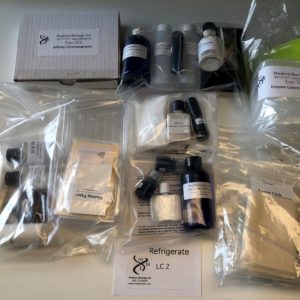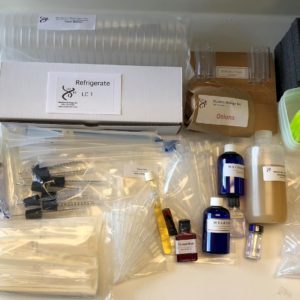Description
This Program is a complete laboratory course for teaching general biology or introductory cell and molecular biology. Like all of our other experiments, the LC6 is designed for 16 students working in pairs. This course provides essentially all of the chemicals and instructions that are needed to teach fifteen, 3-hour laboratory sessions or twenty-five 1-hour laboratory sessions. The course consists of a series of experiments that are presented in a comprehensive integrated laboratory manual which is also provided on a USB flash drive in PDF format.
In the first two sections of the course, students study topics in protein biology and biochemistry such as protein structure, function, and isolation. Experiments on enzyme kinetics and cellular metabolism are then carried out. Students perform a project of their own design in the second section of the course. The projects focus on the characterization of plant peroxidases. A number of other optional student-designed experiments are outlined in the Instructor manual of the program and basic reagents are provided in order for the student to carry out their hypothesis driven projects.
Experiments on the properties and structure of DNA are presented in the next section of the course. Here, students perform experiments that deal with genome organization and specific gene function. Techniques include DNA electrophoresis, cell fractionation, DNA isolation, restriction nuclease mapping, and basic cloning procedures. In the final section of the course students study the genetics, biochemistry and molecular biology of hemoglobin.
Features
Suitability – General college-level biology, advanced high school biology or introductory cell and molecular biology for college sophomores and juniors.
Topics include evolution, protein biochemistry and enzyme action, photosynthesis and cell respiration, immunology, animal and plant physiology, anatomy and histology, cell biology, molecular biology and biotechnology, bacteriology, genetics, molecular genetics and genomics, and human genetic diseases.
Lab Schedule – Fifteen 3 hour lab sessions or twenty-five 1-hour lab
Cost – $52 per student per student per fifteen 3-hour laboratory sessions, excluding costs of manuals if the students work in pairs.
Student Designed Experiments – Ideas for over 50 optional student- designed experiments are outlined in the Instructor manual of the program and basic reagents are provided in order for the student to carry out their hypothesis driven projects.
Equipment Requirements include horizontal electrophoresis equipment, microliter dispensers, a microcentrifuge and water bath. A colorimeter is recommended but not absolutely necessary for parts of two experiments.
Experiments
Proteins and Pigments
1. Electrophoretic and Chromatographic Analysis of Photosynthetic Pigments from Blue-Green Algae.
Cyanobactera, also known as blue-green algae, obtain their energy by photosynthesis using sunlight as their energy source. These organisms have been considered to be the oldest and the most important bacteria on the earth. It is believed that they were responsible for the initial oxygenation of the earth’s atmosphere through photosynthesis and it is also felt they were the precursors to the chloroplasts that are found in true algae and plants. There are two classes of photosynthetic pigments in Cyanobactera. The first class contains water- soluble proteins and the major protein is called Phycocyanin, which is blue. The other classes of photosynthetic pigments that include the carotinoids and chlorophylls are small molecular weight molecules and are insoluble in water but soluble in organic solvents such as alcohol. In this laboratory exercise, students isolate and characterize both groups of pigments. In part A of this exercise, students prepare a water-soluble extract from blue green algae and show that it contains the single major protein Phycocyanin by electrophoresis as shown in the gel. They also determine the charge of this protein by comparing its electrophoretic mobility to the mobilities of proteins and dyes with known charges. In part B, they prepare an alcohol extract and analyze the smaller alcohol soluble pigments by thin layer chromatography in order to identify the chlorophylls and major carotenoid pigments. The results of this two-part study give students practical hands-on experience with isolation of components from cells as well as electrophoresis and thin layer chromatography and introduces them to one of the most important organisms on the earth.
2. Specificity of Albumin Binding
The binding of an enzyme to its substrate is only one example of the many specific molecular interactions that occur in biological systems. An analogous binding process occurs with serum albumin, which binds certain small molecular weight compounds and serves as a carrier molecule for these compounds in blood. In this exercise, students use an electrophoretic assay to examine the binding of various dyes to cow albumin. The results of this graphic analysis show that the binding of dyes to albumin is saturable, specific, compatible, and dependent on the native structure of the protein.
Enzymes and Metabolism
3. Enzyme Action and Kinetics
This set of experiments was designed to give students a basic understanding of enzyme kinetics. In the first experiment in this series, students prepare an extract from wheat germ. They then determined the initial velocity of the reaction catalyzed by purified acid phosphatase and by the acid phosphatase activity present in the extract. From these data, they estimate the amount of the enzyme that is present in the wheat germ. In the second experiment, the student examines the effects of substrate concentration on the reaction velocity. The results enable them to determine the Vmax and Km of the enzyme catalyzed reaction.
4. Effects of temperature on respiration
Respiration can be viewed as a series of enzyme catalyzed reactions in which carbohydrates, proteins, and fats are broken down to carbon dioxide and water with the release of energy. During the process, hydrogen is removed from the fuel molecules and oxygen is consumed. With this background information, students measure oxygen consumption and hydrogen liberation in germinating barley and corn at different temperatures. The program provides eight calibrated respirometers for measurement of oxygen consumption and the chemicals required to perform a graphic dye reduction assay.
Cell Biology and Molecular Evolution
5. A rapid Immunological Method to Study Evolution
Each protein carries in its amino acid sequence information pertaining to its evolutionary history and origin, and provides clues to the evolutionary history of the organism in which it is found. Indeed, proteins existing today are in effect living fossils. This concept is illustrated in this exercise where students examine the abilities of antibodies against cow gamma globulin to react with gamma globulins in the sera of cow, goat, sheep, horse, and chicken. The results of the experiment will enable the student to answer the questions posed in the Student Guide provided with the exercise. Answers to these questions are given in the Instructor Guide. The method used for the experiment involves dotting small quantities of serum onto nitrocellulose and then incubating the nitrocellulose with an enzyme-linked antibody against cow gamma globulin. Following development of the nitrocellulose, purple dots appear with intensities that are proportional to the reactivity of the antibody.
6. Localizing tubulin by Immunohistochemistry
Microtubules are hollow cylinders made up of polymers of the protein tubulin. Microtubules are major components of cilia and flagella, which are tail like projections that are covered by a plasma membrane and extend outwards from the cell. Motile cilia are used for locomotion and food gathering by some protozoa and are found in the lining of the trachea, where their wave like motion propels mucus, dust and other foreign matter out of the lungs. In this exercise, students use the powerful technique of immunohistochemistry to localize tubulin in the esophagus and trachea. The provided tissue sections are exposed to a tubulin monoclonal antibody, which binds to the tubulin. The sections are then incubated with a secondary antibody, which binds to the first antibody. The second antibody is complexed with peroxidase, which catalyzes a color producing reaction. Following the addition of a non-toxic peroxidase substrate, the peroxidase converts the colorless substrate to a blue product, thus “staining” the area containing tubulin. As can be seen in the photographs in panels A-C at the right, the cilia that line the trachea are stained in a highly selective manner in keeping with the high concentrations of microtubules that make up these structures. In the course of these studies, students also become familiar with the four basic tissue types and the structure of tubular organs and identify representative examples of these features in tissue sections that they prepare.
Student Designed Experiments
7. Characterization of Peroxidase in Plants-Student DesignedProjects
These experiments were designed to actively engage students in exciting
biological research projects of their own design. The projects focus on
peroxidases, which form a large family of related enzymes that are ubiquitous in plants. Plant peroxidase isoenzymes can be tissue specific, developmentally regulated and display variable tissue and, high salt and disease resistance defense reactions and this induction may be related to the abilities of peroxidases to strengthen the plant cell wall and to kill microorganisms. Students begin their projects with a hypothesis, which is a statement of an ideal that they will test in the laboratory. They then test their hypothesis by carrying out a series of experiments using the materials provided with the program and vegetables, intact plants or roots and stems. They first use the technique of tissue printing which enables them to localize the peroxidases in tissue sections. They then quantify peroxidase activity by using a DOT-blot assay and Spectrophotometric procedures. Students also carry out an electrophoresis analysis in order to characterize peroxidase isoenzymes in plant extracts that they prepare. In the final section of the program, students are given detailed instructions for organizing their data for presentation in a scientific paper. They are then instructed to write a paper that conforms to the style of a scientific publication using the detailed steps that are presented in the laboratory manuals.
DNA and the Cell Nucleus
8. Properties of DNA and Cell Fractionation and DNA isolation
A DNA molecule from a single human chromosome is about 4 cm long and the length of DNA in an individual is about 200 times the distance from the earth to the sun. Isolated DNA in a test tube is also a long, stiff molecule. When alcohol is added to a DNA solution, the DNA fibers precipitate and can be spooled onto a glass rod. This feature of DNA is illustrated in the first part of this lab period. In the second part, students isolate nuclei from calf thymus tissue. The DNA is then extracted from the nuclei by a simple procedure that uses a detergent and alcohol.
9. Anatomy and Evolution of the Genome
Common plasmids are simple DNA molecules, which contain a few genes and regulatory elements. Most viral genomes are more complex. For example, the genome of phage lambda contains approximately 50 genes. About 4,000 genes are present in the E.coli genome while there is approximately 1,000 times more DNA in the genome of a mammal. This progression in genome complexity is the topic of this exercise. Here, students compare the electrophoretic patterns of restriction digests of a plasmid, phage lambda DNA, and cow DNA from thymus and kidney.
10. Specific Binding of Dyes to DNA
Proteins that bind to DNA control the processes of gene regulation and DNA replication. The electrophoretic mobility band shift assay is a common technique used to study such specific protein-DNA interactions. In this exercise, students use this assay to identify dye molecules that bind to DNA and attempt to determine the mechanism by which these drugs interact with the DNA molecule.
Molecular Genetics Genetics and Biochemistry of Hemoglobin
11. DNA Cloning and Genotype to Phenotype
This exercise was designed to provide an exciting introduction to specific gene structure and function. The students are given four tubes that are labeled Plasmid A-D. which are identified in the instructor’s guide. One plasmid (A) has a functional gene for the enzyme the
ß-galactosidase while tube B contains an inactive form of this gene because it contains a segment of foreign DNA. The tube labeled C contains water while tube D contains the lux operon. Bacteria thatmcarry this plasmid glow in the dark. In the first part of the exercise, students analyze restriction digests of the plasmids in order to determine which plasmid should have a functional ß-galactosidase gene. In the second part of the exercise, the plasmids are introduced into E.coli by transformation and the color of the resulting colonies (blue or white) is then used to assess the functional status of the ß-galactosidase gene. The bacteria are also viewed in the dark for glowing in order to see which plasmid contains the lux operon. By comparing the results they identify the plasmids and relate the genotypes of the plasmids to the phenotypes conferred by the plasmids in E.coli.
12. Sickle Cell Anemia
Many changes in the structure of hemoglobin have arisen by mutations. About one person in 100 carries a mutant hemoglobin gene, and these individuals have abnormal hemoglobin molecules in their blood. One of the most common abnormal hemoglobins is hemoglobin S, which causes sickle cell anemia. When the gene for hemoglobin S is inherited from both parents, all of the hemoglobin in the circulation is hemoglobin S and the individual suffers from severe anemia. An electrophoretic procedure is used to illustrate the various types of hemoglobin in the first part of this laboratory exercise. In the second part, Students use the technique of gel filtration chromatography to isolate hemoglobin and then to determine its size.
13. Analysis of a Mutant Hemoglobin Gene
A mutation is a change in the nucleotide sequence of DNA, 12345678 which leads to an inherited change in an organism. Restriction
endonucleases provide valuable tools for characterizing
mutations at the DNA level. This principle is illustrated in the
exercise where students digest a normal and a mutant gene with EcoR1 and Hae III and then analyze the DNA fragments from each by electrophoresis as shown in the figure below. The gene is from rabbit and codes for the ß-globin chain-s of hemoglobin.
 Due to Customs restrictions, we only accept orders from educational institutions within the Continental United States, Alaska or Hawaii.
Due to Customs restrictions, we only accept orders from educational institutions within the Continental United States, Alaska or Hawaii. 


